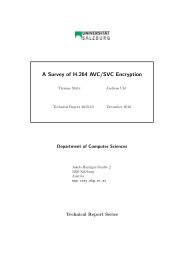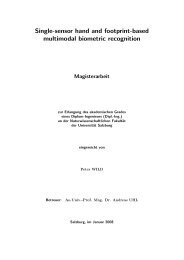Pit Pattern Classification in Colonoscopy using Wavelets - WaveLab
Pit Pattern Classification in Colonoscopy using Wavelets - WaveLab
Pit Pattern Classification in Colonoscopy using Wavelets - WaveLab
Create successful ePaper yourself
Turn your PDF publications into a flip-book with our unique Google optimized e-Paper software.
4 Automated pit pattern classification<br />
4.3 Structure-based classification<br />
While the classification methods presented <strong>in</strong> the previous sections were based on features<br />
based on wavelet coefficients and therefore needed some classifier to be tra<strong>in</strong>ed, the next<br />
sections <strong>in</strong>troduce a classification method, which does not <strong>in</strong>volve any feature extraction<br />
<strong>in</strong> terms of image features. Instead the “centroid classification” tries to assign pit pattern<br />
classes to unknown images by decompos<strong>in</strong>g the image and compare the result<strong>in</strong>g decomposition<br />
structure to the centroids of the respective classes.<br />
But first of all a quick <strong>in</strong>troduction <strong>in</strong>to quadtrees and a description of the used quadtree<br />
distance metrics are given.<br />
4.3.1 A quick quadtree <strong>in</strong>troduction<br />
A quadtree is a tree with the important property, that every node <strong>in</strong> a quadtree hav<strong>in</strong>g child<br />
nodes has exactly four child nodes. As all trees <strong>in</strong> mathematics a quadtree can be def<strong>in</strong>ed<br />
like a graph by a vertex set V an edge set E. For a tree with n ∈ N + nodes this can be<br />
written formally as<br />
V = {v 1 , . . . , v n } with |V | = n (4.27)<br />
E = {(v i , v j )|i ≠ j, v i , v j ∈ V } (4.28)<br />
where the elements v i ∈ V are called vertices and the elements e j ∈ E are called edges.<br />
Vertices which do not have any child nodes are called leaf nodes.<br />
4.3.2 Distance by unique nodes<br />
This distance metric tries to measure a distance between two quadtrees by first assign<strong>in</strong>g<br />
each node of the quadtrees an unique node value, which is unique among all possible<br />
quadtrees. Then for each quadtree a list of quadtree node values is generated which are<br />
then compared aga<strong>in</strong>st each other to identify nodes which appear <strong>in</strong> one of the two trees<br />
only.<br />
4.3.2.1 Unique node values<br />
To be able to compare different quadtrees, we must be able to uniquely identify a node<br />
accord<strong>in</strong>g to its position <strong>in</strong> the quadtree. To accomplish this we assign a unique number to<br />
each node accord<strong>in</strong>g to its position <strong>in</strong> the tree.<br />
44








